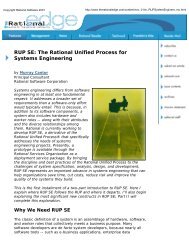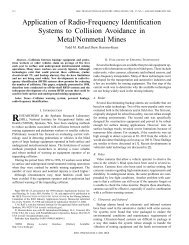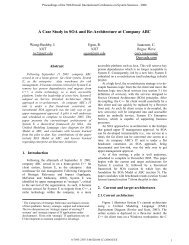Deriving use cases from organizational modeling - Requirements ...
Deriving use cases from organizational modeling - Requirements ...
Deriving use cases from organizational modeling - Requirements ...
You also want an ePaper? Increase the reach of your titles
YUMPU automatically turns print PDFs into web optimized ePapers that Google loves.
considered as a Use Case actor. The other i* actors areconsidered appropriate beca<strong>use</strong> their strategicdependencies refer to relevant aspects for the meetingscheduler system (guideline 3) development. So, thelist of candidates Use Cases actors includes: MeetingInitiator, Meeting Participant and ImportantParticipant. We also note that Important Participant isa type (relationship IS-A) of participant. According toguideline 4 (1 st step), we consider this actor aspecialization of Meeting Participant actor.The next step is to discover and relate Use Cases foreach actor according to the guidelines presented in the 2ºStep (Discovering Use Cases for the Actors).• Initially, following the guideline 5 and observing theSD model presented in Figure 1 we can generate thetable 3.ActorDependencyType ofDependencyGuidelineto be <strong>use</strong>dMeetingAttendsMeeting(p,m) Goal (G5.1)ParticipantMeetingEnterAvailDates(m) Task (G5.2)ParticipantMeetingAgreement(m,p) Resource (G5.3)ParticipantMeeting Initiator EnterDateRange(m) Task (G5.2)Table 3. Gathered information <strong>from</strong> SD Models toderive Use Cases for the Meeting Scheduler System.• Thus, for the Meeting Participant actor, observing thisactor as Dependee, we can indicate some Use Casesoriginated <strong>from</strong> the actor dependency relationships(guideline 5). Initially, we should consider the goaldependency (guideline 5.1) of the actor as Dependee.In table 3, we verify the goal AttendsMeeting(p,m),which represents the need of the meeting participantactor to attend the meeting. This goal originates theUse Case AttendsMeeting. Several steps are necessaryto achieve this goal. Typically, this is a <strong>use</strong>r goal(guideline 7). The fulfillment of the Use Case goalbrings a relevant result for Meeting Participant actor,allowing it to attend to the meeting. Usually, thedescription of the primary scenario (to beaccomplished later) for this Use Case, will presentother <strong>use</strong>r goals that can originate new Use Cases forthe system.The next dependency associated with the MeetingParticipant actor is the task dependencyEnterAvailDates(m). According to guideline 5.2, wecan consider the need of several interaction stepsamong the participants (Meeting Participant actor) andthe meeting scheduler system to enter available dates.Some steps could include participants to supply a listof exclusion dates and preferred dates in a particularformat, to validate these dates by the system, etc.Thus, the task EnterAvailDates(m) generate the UseCase EnterAvailDates for the Meeting ParticipantActor.Continuing our analysis, we can observe associatedwith the Meeting Participant (Dependee) actor theresource dependency Agreement(m,p). Followingguideline 5.3, we conclude that the main goal ofobtaining of Agreement(m,p) resource is an scheduleddate agreement <strong>from</strong> each participant. We couldconsider that in this agreement process, eachparticipant could agree with the proposed meeting datewith certain schedule restrictions or duration time.Still, the agreement could involve an analysis of otherpossible dates. In other words, the schedule of datesrequires several interaction steps between the systemand the Meeting Participant actor, which defines theAgreement Use Case of the Meeting Participant actor.• To discovery of Use Cases candidates for the MeetingInitiator actor follows the same guidelines (2º Step).We have one dependency associated with the MeetingInitiator actor (see table 3): the taskEnterDateRange(m). Using guideline 5.2 for this taskdependency we observe that to supply a date range forthe meeting scheduling can include several aspects(sub-tasks) such as to associate range dates withspecific meetings, to establish priorities for specificmeetings, etc. Thus, <strong>from</strong> the EnterDateRange(m) taskwe generate the EnterDateRange Use Case for theMeeting Initiator actor.Having considered all dependencies for the MeetingInitiator as Dependee, we should now consider specialsituations (guideline 6). Observing Figure 1, wevisualize the goal dependency MeetingBeScheduledbetween Meeting Initiator and Meeting Scheduler(software to be developed), which requires some sortof interaction. Therefore, we can define theMeetingBeScheduled Use Case that represents the <strong>use</strong>of the system by the Meeting Initiator actor. In thisUse Case, we describe the details of the meetingschedule process. Note that in this special situationthe depender (meeting initiator) is the Use Case actor.• Finally, following the guideline 7 we can to classifyeach discovered Use Case goal, as showed in the table4.Thereby, after we have <strong>use</strong>d the proposed guidelines(2º Step), we have discovered EnterDateRange andMeetingBeScheduled Use Cases for the Meeting Initiatoractor as well as AttendsMeeting, EnterAvailDates andAgreement Use Cases for the Meeting Participant actor.Therefore, we can begin the description of the primaryand secondary scenarios and the Use Cases relationships(3º Step). At this point, the Strategic Rationale (SR)model is <strong>use</strong>d as source of information for the scenariodescription and the Use Cases relationships.Proceedings of the IEEE Joint International Conference on <strong>Requirements</strong> Engineering (RE’02)1090-705X/02 $17.00 © 2002 IEEE






